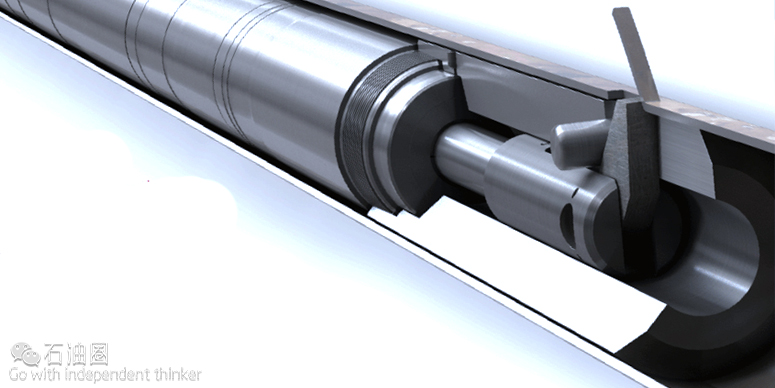An operator in Baku, Azerbaijan was planning to create a gas lift configuration and needed to perforate 7-in., 32-lbf, 13% chrome, up to 0.51-in.wall thickness, heavy wall tubing without explosives. A nonexplosive mechanical tubing perforator conveyed on electric line avoided damaging the in-situ control lines and the casing. To meet the job parameters, a mechanical tubing perforator capable of generating up to 100,000 lbf necessary to perforate the 7-in. tubing was developed.
The 7-in. downhole electrical power generator actuated tubing perforator tool provided a controlled, nonexplosive, cost-effective solution to create a single perforation hole in tubing or casing without damaging in-situ control lines in the annulus. Tubing to annulus communication was established and through-tubing gas lift straddle was installed to allow increased production. When workover requirements necessitate rapid mobilization, the tubing perforator helps lower costs while providing a safe, effective, and dependable solution for perforating the tubing. Offering conveyance flexibility, the perforator can be run on slickline, electric line, or coiled tubing (CT), providing versatility and economy to meet multiple operational requirements.
This actuated tubing perforator eliminates logistical challenges associated with using explosives, is health, safety, and environment (HSE) and user friendly, and helps reduce rig time by minimizing missed runs. It is compact and heli-lift compliant for portable, rapid deployment and has no risk of damaging annular tubular or casing. Relying on the dependable performance of the tool to provide power, the actuated tubing perforator has proven to be a safe, reliable, and cost-effective means of punching production tubular for circulating purposes.
Acquiring, moving, storing, and handling explosive-based equipment can be very difficult and time-consuming. In many countries where regional security is a concern, the movement of explosives is a controlled activity and can often delay projects. Consequently, when an unplanned event occurs for which pipe severing with explosives is the solution, such as stuck pipe, the drilling rig team might be required to wait several days before performing this job. These types of occurrences are quite common, especially in highly active drilling areas. In some cases, this lost time is conservatively estimated to be more than USD 12 million annually for a land-based operation. It is easily plausible to incur triple these costs for offshore operations, noting that these cost estimates do not account for the revenue losses attributable to a delay in production of hydrocarbons.
The Halliburton Downhole Power Unit® (DPU) Actuated Tubing Perforator offers a nonexplosive, cost-effective solution to create a single perforation hole in tubing or casing. When workover requirements require rapid mobilization, the Tubing Perforator helps cut costs while providing a safe, effective and dependable solution for perforating the tubing. Offering conveyance flexibility, the Perforator can be run on slickline, electric line, or coil tubing, offering versatility and economy to meet multiple operational requirements.
Benefits
• Improved safety and reliability with explosive-free perforating
• Eliminates logistical challenges of explosives
• HSE and user friendly
• Can reduce the cost of perforating tubing
• Reduces rig time by minimizing miss runs with other mechanical perforators
• Conveyance flexible with solutions on slickline, e-line, and coil tubing
• Compact heli-lift compliant for portable, rapid deployment
• No risk of damaging annular tubular
Features
• Operates in multiple tubing grades: J-55, L-80, P-110 and 13 CHR
• Deployed on proven DPU technology
• No jarring to achieve a communication hole
• Doesn’t require explosive-trained personnel
• Offers proven, dependable perforating operation
• Provides consistent penetration performance
Explosive perforating poses many challenges
Wells in the Middle East, both onshore and offshore, often require workover because of the highly corrosive environment to which the downhole equipment is subjected. During these operations, the downhole equipment frequently must be repaired or replaced. To maintain well control during these workovers, a single hole is often necessary to allow the kill fluids to be circulated. Traditionally, these holes are created using explosives and a soft shot perforator or using mechanical hole-punching methods.
These types of solutions can also damage the tubing or casing, causing further issues. Workover jobs requiring a single hole to be punched are often economically compromised by delays in mobilizing explosives and because failures to perforate soft tubing are common when using traditional mechanical hole-punching methods.
Moreover, many countries highly regulate the use of explosives.The operator’s home country requires permitting, special transportation and secure warehousing, all of which can be difficult to arrange in many locations. Offshore rigs could be idled for days while the operator worked out logistical issues.
High failure rate of early mechanical tools raised costs
Before 2006, the average failure rate of mechanical perforators approached 50 percent. As often as not, the operator would have to revert back to explosive perforating to finish the job.The company needed a reliable way to equalize pressure gradually, so that they could pump out fluids safely before work began.
The search for reliable alternatives leads to Halliburton
To improve safety, costs and logistics, in 2006, the operator asked Halliburton to develop a better mechanical alternative. At Halliburton’s Carrollton, Texas facilities, a handpicked crew of engineers began the search for solutions.
Their efforts focused on adapting Halliburton’s field-proven DPU® (downhole power unit) tool to the task. In use since the 1990s, the DPU tool has proven its worth as a nonexplosive alternative to setting plugs worldwide. But could it be adapted to perforating?
Unique design harnesses linear force of the DPU tool
As a screw inside the DPU tool moves downward, it forces the tip of the blade – which rotates on a fulcrum – against the wall of the tubing. Eventually the tubing begins to perforate. Starting with a pinhole, the blade gradually enlarges the perforation to about one half-inch across. As the DPU tool continues to apply pressure against the blade, the blade flips over and retracts back into the tool so that the tool can be removed from the hole.The tool produces a puncture in the tubing within minutes.


 石油圈
石油圈
